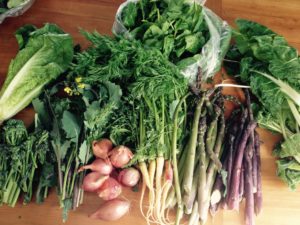31 Mar
Pizza in Paris
Disclaimer: This is sort of a long one that gets a little off topic (very unusual for me, right?!). If you can make it through, you definitely deserve a pizza. For that reason I have created a TOC so you may skip ahead.
So anyway, I went to Paris the other day, because, you know, why not. While I was there I had the opportunity to talk shop with a friend of mine who is also a self-proclaimed amazing chef. While I don’t have firsthand evidence of his skills, I do take his word for it because he is tall and French and speaks in an authoritative manner. And then also of course we all know that the French can never be mistaken when it comes to food.
On this occasion we were talking about pizza, as you do, which was a little ironic because France is actually not known for excellence in this category … or perhaps it’s totally un-ironic because if you want to have good pizza in France you must obviously make it yourself. This is not dissimilar to my problem in Philadelphia when it comes to Mexican food. But that’s another rant story.
Anyway, my friend shared with me that he always makes his own pizza but he uses sauce from a jar. Nothing against jar sauce, and if you have a good one you like, please let me know – however, I am picky about sauce so I usually make it myself.
Inspired by this recent conversation, I decided it was time to share my pizza recipe, from dough to sauce to cheese and everything in between. If you want proof points for why it’s good, I can offer up the testimonial from my son “I like Mom’s pizza better than order-out pizza.” In my house there is no higher praise than that. So here I am doing my part to bring quality pizza to people all over the world.
Before we get started, IMPORTANT NOTE: The key to keeping homemade pizza a reasonably practical dinner option is to spend the time to make the dough and sauce in a big batch, and then freeze it for assembly on demand. This recipe assumes that basic strategy. ALSO: Once you have made all the things, skip to the end for how to combine them into a pizza.
The Dough (pronounced “doe,” rhymes with “so” – for my international readers)
Ingredients
I have some bad news for you, this is going to take a couple days if you want it to be really, really perfect. If you don’t mind it being only mostly perfect, it doesn’t take long at all. In actuality, the time that you are actively working on it is about 20 minutes, but there is a lot of resting the dough and punching it down and resting it again, etc etc etc. So, this is my preferred method but feel free to use THE SHORTCUT (see below).
- 4 cups flour
- 2 ¼ tsp or ¼ oz yeast
- 1 – 1½ c warm water (100-110 degrees F)
- Small handful of sea salt
- Olive oil for drizzling
- Corn flour, which will be used later when you are actually making the pizza, so don’t worry about it now, just make sure you have it
Instructions
- Dissolve the yeast in the warm water
- Mix the flour and salt together
- Add the water/yeast combo into the flour, stirring to combine
- Adjust the water/flour ration if necessary – more water if the dough is too dry, more flour if the dough is too sticky
- Transfer the dough to a floured surface and knead for about 10 minutes, until smooth
- Transfer the dough to a large oiled bowl, big enough to let it expand to twice its size. Cover it with a damp dish towel, paper towel or plastic cling wrap
- Let the dough rest for a couple hours until it has doubled in size
- Punch it down and return to oiled bowl, covered.
- Now, if you want to do it the long way, what I usually do at this point is this:
a. Refrigerate the dough overnight
b. Punch it down and cover it again
c. Repeat this process so that the dough has risen, been deflated, and re-risen a total of three times
d. What is happening during this time period? Some chemical process is taking place with the yeast and the gluten and it leads to a chewier crust. This is how I like it. Others might prefer it another way. No judgment on my part, however if you ever feel your pizza crust isn’t chewy enough, you should try it this way.
e. Once the dough has risen and re-risen enough times, divide it into three, drop it into three storage containers (I use Ziploc bags and I usually label them with the date because I’m meticulous like that). - THE SHORT CUT: If you want to take the short cut, all you have to do after step 7 is punch the dough, divide it into 3 equal portions, place in 3 oiled bowls lightly covered with a damp towel or plastic wrap, let them rest one more hour and then place in separate containers to freeze. Now you have your dough, so let’s move on. Quoi d’autre? Que mas? Cos’altro? What else?
This is easy so I will try not to waste too much time entertaining myself with unnecessary exposition.
Ingredients
- Olive oil, about 3 tbsp
- Garlic, 4 large cloves, peeled and smashed (I just press them with the side of a knife until they burst, which is pretty fun)
- One big white onion, halved and roughly sliced
- One 28 oz can of plum tomatoes OR two 14 oz cans of whatever kind of tomatoes you have OR you could even use an equivalent combination of fresh tomatoes and canned tomatoes OR you could completely use fresh tomatoes, but if you do that, I would roast them in the broiler for a minute and pull off the skins before cooking them
- Italian seasoning to taste (oregano, thyme, basil) – I used dried seasoning here because I don’t like how fresh herbs get creepy when they’re cooked and frozen
- 1-2 tbsp of tomato paste, to taste
- Sea salt and freshly cracked black pepper to taste (I usually throw in a kid-sized handful of each)
You will notice certain recurring themes if you happen to have read my Tomato Soup or Pasta Arrabiata recipe. This is because Italian tomato-based recipes all boil down to these 4 basic things – garlic, onion, tomatoes, seasoning. Proportions and cooking methods are the only variance.
Instructions
- In a large saucepan or stockpot, heat the olive oil
- Throw in the garlic and onion and saute for about 5-10 minutes, until everything is soft, fragrant and the onion is a little gold
- Remove the mixture and transfer to a food processor (CuisinArt or what have you)
- Add the tomatoes and tomato paste to the food processor and blend until smooth
- Transfer the whole mix back to the saucepan or pot
- Add seasonings to taste and cook on medium until the sauce is thickened to your desired consistency – this usually takes me about 10 minutes
- Taste and adjust seasonings if necessary
- Allow to cool and divide into three storage containers to freeze
The Cheese (obviously not vegan but you can use vegan cheese)
The cheese you don’t have to deal with ahead of time. Shred it right before you start the pizza.
This part is also easy, but it’s the most difficult to put into words, because it’s not so much a recipe as a philosophy. Hear me out for a minute:
Here’s a little known fact: the perfect pizza cheese is NOT mozzarella alone. Mozzarella is just one component of the perfect pizza cheese because there should always be more than one – there should be at least two and possibly several, depending on what you like. No one can tell you what your favorite pizza cheese blend will be, it’s something you’re going to have to figure out on your own. But whatever your taste, you must bear in mind these principles:
You need at least one melting cheese for a base (this would typically be mozzarella)
You need at least one salty cheese (Asiago, Parmesan, Pecorino, Romano, etc)
You may want to add others for character and complexity (cheddar, gouda, goat, feta, etc)
You will have to experiment. I usually use whatever I have on hand, which nearly always includes:
- Mozzarella (should be 50% of the total mix)
- Monterrey Jack
- Parmesan
- Cheddar
I shred about 3 cups per pizza. If I have feta, I may sprinkle it across the top after I’ve spread cheese over the whole pizza.

- Take one of the bags of dough out of the freezer and let it thaw on the counter for an hour or so. It won’t take long. If you’re in a rush, you can run warm water over it (keep it sealed in the bag).
- Preheat your oven to 500 degrees. If you have a pizza stone, place it in the oven before pre-heating so it doesn’t crack with a temperature shock.
- Take one of the sauce containers out and either microwave it or thaw it on the stovetop.
- Shred the cheese.
- Lay out a piece of parchment paper on a large, smooth surface,
- Spread about a half cup of flour on the parchment and keep some more nearby in case you need it.
- Rub some flour on your hands and over a rolling pin and get ready to roll out the dough.
- With the floured rolling pin, roll the dough out to a thin circle – not too thin or the pizza will be soggy and fall apart. I usually roll it to about ¼ inch thickness – the pizza diameter will be about 9-11 inches.
- THIS IS VERY IMPORTANT: When the pizza is rolled, lift up the dough and spread a handful of corn flour underneath it. This will prevent it from sticking to the parchment
- Spread the sauce evenly over the pizza to about 1 inch from the edge of the dough; I use a big flat spoon for this
- Sprinkle the cheese evenly over the pizza
- Layer on whatever ingredients you want – I usually include:
- Prosciutto (obvs not vegan or vegetarian)
- Fresh basil
- Black olives
- If I don’t have fresh basil and prosciutto, I will usually throw a handful of sliced jalapenos, but I don’t do that with basil and prosciutto because that would not be a very good flavor profile
- Honestly toppings are really up to you and what you want on your pizza
- Now transfer the whole thing onto the pizza stone – parchment paper and all. I usually slide the pizza onto a pizza paddle and then slide it over to the stone (or baking sheet or oven rack – however you roll).
- Cook for 5 – 10 minutes depending on desired crust texture – I like mine a light golden brown and a little chewy.
So, there you have it. Thanks for sticking with me through all that, and I hope you enjoy!




Recent Comments